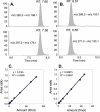Distribution of DNA adducts caused by inhaled formaldehyde is consistent with induction of nasal carcinoma but not leukemia
- PMID: 20176625
- PMCID: PMC2905397
- DOI: 10.1093/toxsci/kfq061
Distribution of DNA adducts caused by inhaled formaldehyde is consistent with induction of nasal carcinoma but not leukemia
Abstract
Inhaled formaldehyde is classified as a known human and animal carcinogen, causing nasopharyngeal cancer. Additionally, limited epidemiological evidence for leukemia in humans is available; however, this is inconsistent across studies. Both genotoxicity and cytotoxicity are key events in formaldehyde nasal carcinogenicity in rats, but mechanistic data for leukemia are not well established. Formation of DNA adducts is a key event in initiating carcinogenesis. Formaldehyde can induce DNA monoadducts, DNA-DNA cross-links, and DNA protein cross-links. In this study, highly sensitive liquid chromatography-tandem mass spectrometry-selected reaction monitoringmethods were developed and [(13)CD(2)]-formaldehyde exposures utilized, allowing differentiation of DNA adducts and DNA-DNA cross-links originating from endogenous and inhalation-derived formaldehyde exposure. The results show that exogenous formaldehyde induced N(2)-hydroxymethyl-dG monoadducts and dG-dG cross-links in DNA from rat respiratory nasal mucosa but did not form [(13)CD(2)]-adducts in sites remote to the portal of entry, even when five times more DNA was analyzed. Furthermore, no N(6)-HO(13)CD(2)-dA adducts were detected in nasal DNA. In contrast, high amounts of endogenous formaldehyde dG and dA monoadducts were present in all tissues examined. The number of exogenous N(2)-HO(13)CD(2)-dG in 1- and 5-day nasal DNA samples from rats exposed to 10-ppm [(13)CD(2)]-formaldehyde was 1.28 +/- 0.49 and 2.43 +/- 0.78 adducts/10(7) dG, respectively, while 2.63 +/- 0.73 and 2.84 +/- 1.13 N(2)-HOCH(2)-dG adducts/10(7) dG and 3.95 +/- 0.26 and 3.61 +/- 0.95 N(6)-HOCH(2)-dA endogenous adducts/10(7) dA were present. This study provides strong evidence supporting a genotoxic and cytotoxic mode of action for the carcinogenesis of inhaled formaldehyde in respiratory nasal epithelium but does not support the biological plausibility that inhaled formaldehyde also causes leukemia.
Figures







Comment in
-
Considerations for the implausibility of leukemia induction by formaldehyde.Toxicol Sci. 2011 Mar;120(1):230-2; author reply 233. doi: 10.1093/toxsci/kfq340. Epub 2010 Nov 8. Toxicol Sci. 2011. PMID: 21059796 No abstract available.
References
-
- Casanova M, Morgan KT, Gross EA, Moss OR, Heck HA. DNA-protein cross-links and cell replication at specific sites in the nose of F344 rats exposed subchronically to formaldehyde. Fundam. Appl. Toxicol. 1994;23:525–536. - PubMed
-
- Casanova M, Morgan KT, Steinhagen WH, Everitt JI, Popp JA, Heck HD. Covalent binding of inhaled formaldehyde to DNA in the respiratory tract of rhesus monkeys: pharmacokinetics, rat-to-monkey interspecies scaling, and extrapolation to man. Fundam. Appl. Toxicol. 1991;17:409–428. - PubMed
-
- Casanova-Schmitz M, Heck HD. Effects of formaldehyde exposure on the extractability of DNA from proteins in the rat nasal mucosa. Toxicol. Appl. Pharmacol. 1983;70:121–132. - PubMed
-
- Casanova-Schmitz M, Starr TB, Heck HD. Differentiation between metabolic incorporation and covalent binding in the labeling of macromolecules in the rat nasal mucosa and bone marrow by inhaled [14C]- and [3H]formaldehyde. Toxicol. Appl. Pharmacol. 1984;76:26–44. - PubMed
Publication types
MeSH terms
Substances
Grants and funding
LinkOut - more resources
Full Text Sources
Other Literature Sources
Medical

